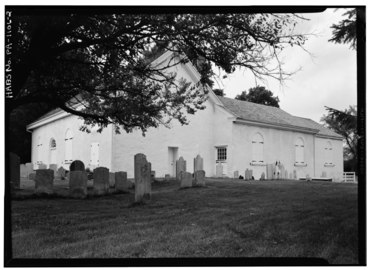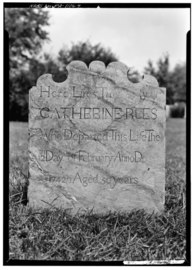St. Peter's Church in the Great Valley
St. Peter's Church in the Great Valley | |
 St. Peter's Church in the Great Valley, April 2010 | |
| Location | 2475 St. Peter's Rd., Malvern, Pa. 19355 South of Phoenixville off Pennsylvania Route 423, East Whiteland Township, Pennsylvania |
|---|---|
| Coordinates | 40°4′5″N 75°31′33″W / 40.06806°N 75.52583°W |
| Area | 1 acre (0.40 ha) |
| Built | 1744 |
| Architectural style | Colonial |
| NRHP reference No. | 77001155[1] |
| Added to NRHP | November 21, 1977 |
St. Peter's Church in the Great Valley is a historic Episcopal church. It began in 1704 as a missionary parish of the Church of England. The church is located in Malvern and near Phoenixville, East Whiteland Township, Chester County, Pennsylvania. A more detailed history of the church is on their website. The parish is part of the Episcopal Diocese of Pennsylvania.
The current stone church building was constructed sporadically between 1728-1744 to replace an earlier wooden building built by 1710. The 1744 building was a stone structure with a medium pitched gable roof measuring 47 feet by 28 feet. A two-story addition was built in 1856, and the 1 1/2-story Parish House added in 1901. During the American Revolution, the church was used as a hospital by both British and American forces.[2]
By local tradition, after the nearby Battle of Paoli in 1777 the British Army, recognizing St. Peter's as part of the Church of England, oversaw the burial of a British officer (believed to be Captain William Wolfe, commander of the Light Company of the British 40th Regiment of Foot), at least two other unidentified British soldiers, and at least five unidentified American soldiers killed in the battle. The British and American men are buried side by side along the old west wall of the churchyard. Several small American and British flags are traditionally kept at the graves out of respect for the soldiers from both armies (see illustration, below).[3]
Over its 300+ year history, St. Peter’s has been led by more than three dozen missionaries and priests. After a series of architectural modernizations (many later referred to as vandalisms) in the nineteenth and early twentieth century, the church was carefully restored in 1944 to somewhat approximate the simplicity of the original 1744 building.
Early in the 21st century the growing congregation built a timber-framed parish center and modern worship space designed in a style reminiscent of the original Welsh barns in the area. The original church building, and the adjacent burial ground, was placed on the National Register of Historic Places in 1977.[1]
-
Sheep trim the grass in the graveyard.
-
Common grave of British and American soldiers killed at the Battle of Paoli in the American Revolution.
References
- ^ a b "National Register Information System". National Register of Historic Places. National Park Service. March 13, 2009.
- ^ "National Historic Landmarks & National Register of Historic Places in Pennsylvania" (Searchable database). CRGIS: Cultural Resources Geographic Information System. Note: This includes unknown (n.d.). "National Register of Historic Places Inventory Nomination Form: St. Peter's Church in the Great Valley" (PDF). Retrieved 2012-10-30.
- ^ "History of the Church". Retrieved 25 May 2020.
External links
- Official Website
- Church of St. Peter-in-the-Great Valley, Saint Peter's Road (East Whiteland Township), Devault, Chester County, PA: 4 photos, 6 data pages, and 1 photo caption page at Historic American Buildings Survey
- Historic American Buildings Survey in Pennsylvania
- Cemeteries in Chester County, Pennsylvania
- Churches on the National Register of Historic Places in Pennsylvania
- Churches completed in 1744
- 18th-century Episcopal church buildings
- Churches in Chester County, Pennsylvania
- Episcopal churches in Pennsylvania
- National Register of Historic Places in Chester County, Pennsylvania
- 1744 establishments in Pennsylvania








